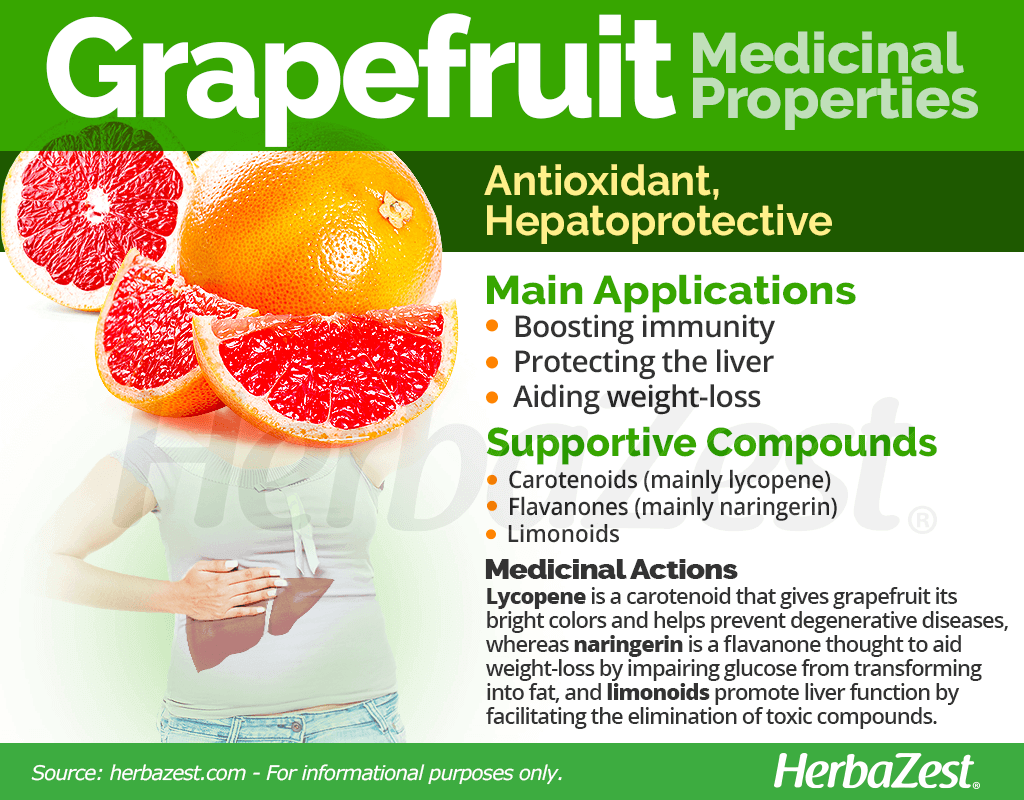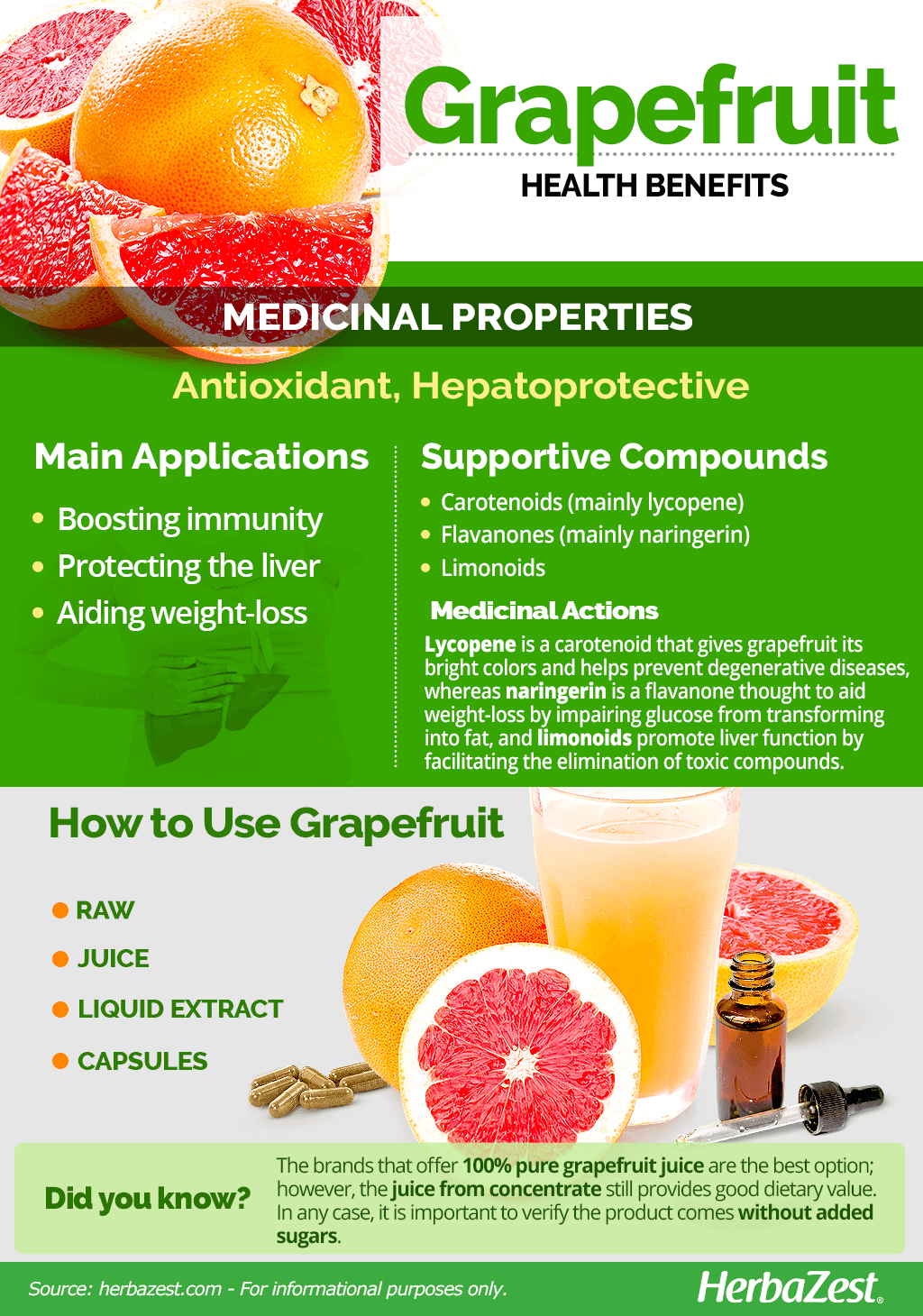The only citrus species native to the Americas, the grapefruit (Citrus paradisi) is a cross between orange (Citrus sinensis) and pommel (Citrus maxima). Slightly less sweet than an orange, it nevertheless has a pleasant, tart flavor depending on the variety, and comes with a long list of health benefits thanks to its high vitamin C content and antioxidant properties.
Grapefruit Medicinal Properties
- Medicinal action Antioxidant, Hepatoprotective
- Key constituents Carotenoids, flavanones, limonoids
- Ways to use Capsules, Liquid extracts, Food, Juiced
- Medicinal rating (3) Reasonably useful plant
- Safety ranking Use with caution
Health Benefits of Grapefruit
The nutritional value of grapefruit lies mainly in its high content of essential nutrients; however, the phytocompounds found in the pulp, seeds, and peel of this citrus are responsible for most of its medicinal benefits, which are mainly:
Boosting immunity. The antioxidant properties of grapefruit strength the immune system, which protects the body from harmful viruses and bacteria.
Protecting the liver. The bioactive compounds of grapefruit help improve liver function, aiding the body to get rid of toxins.
- Aiding weight-loss. The grapefruit is a staple of many weight-loss diets, since it is thought speed up metabolism.
Scientific studies suggest that the medicinal properties of grapefruit may also help with:
Treating infections. Studies have shown that grapefruit can inhibit the proliferation of harmful bacteria, and it has proven to be useful for managing E. coli infections.
How It Works
The main phytocompounds found in grapefruit are flavonoids, particularly flavanones, which account for about 98% of this citrus fruit and are thought to be responsible for its anti-inflammatory, cardioprotective, and antibacterial properties.
The amount of flavanones in grapefruit depends on the variety; however, naringin is present at the highest concentration, followed by narirutin. While further studies are necessary, a combined form of naringin and narirutin, called naringerin, is believed to aid weight-loss by impairing glucose from building up in adipose tissue, increasing insulin resistance. Other important flavanones in grapefruit are hesperidin, poncirin, neohesperidin, didymin, and quercetin.
Grapefruit's juice, seeds, and peel also carry a type of terpenoids called limonoids, which are responsible not only for the slightly bitter flavor of this citrus, but also for its antibacterial, antifungal, antiviral, and hepatoprotective properties. The limonoids have the ability to activate an enzyme called glutathione-S-transferase, which aids liver function by making toxic compounds more easily soluble in water, thus facilitating their elimination from the body.
The pink and red grapefruit varieties are also rich in carotenoids, mainly lycopene, which is a powerful antioxidant compound that helps prevent degenerative diseases and also gives this citrus fruit its bright colors.
Consuming grapefruit has been shown to help lower cholesterol, and there is even a diet devoted specifically to the health benefits this citrus can provide.
LIMONOIDS CAN INTERRUPT COMMUNICATION BETWEEN INFECTIOUS BACTERIAL CELLS.
Other herbs with strong immune boosting properties are camu camu and goji berries, whereas artichoke and milk thistle also support liver health.
Grapefruit Side Effects & Cautions
It has been found that two related furanocoumarins in grapefruit, 6',7'-
Grapefruit should not be consumed by people taking statins (cholesterol-lowering drugs), as well as antihypertensives, immunosuppressants, anxiolytics, antiarrhythmics, and antihistamines.
Consuming grapefruit alongside these medications could increase the risk of side effects, including liver and kidney damage.

Grapefruit Nutrition
Grapefruit is a low-carb fruit, with good amounts of dietary fiber, which makes it a staple of many weight-loss diets, but its most abundant nutrient is vitamin C (ascorbic acid), a water-soluble compound that is crucial for maintaining a healthy immune function, as well as for preventing scurvy.
Other important nutrients, provided in good amounts by grapefruit are B complex vitamins, particularly vitamin B5 (pantothenic acid), and vitamin A (from carotenes). Vitamin B5 is necessary for the synthesis of coenzyme A (CoA), a molecule involved in the metabolism of proteins and fats, as well a for speeding up wound healing, whereas vitamin A plays a key role in tissue regeneration, helping neutralize the free radicals that cause cellular decay and preventing age-related diseases.
Grapefruits also contain essential minerals, mainly copper, for blood cells' production and transportation; potassium, necessary for regulating blood pressure and maintaining healthy blood vessels; and magnesium, which plays a key role in the well-functioning of muscles and nerves.
Half of a medium grapefruit (123 g) provide 52 calories and 7% of the recommended daily value for dietary fiber.

How to Consume Grapefruit
- Edible parts Fruit
- Edible uses Beverage
- Taste Sweet, Tart
The most common way to consume grapefruit is in its fresh form, either raw or in the form of juice. However, the properties of grapefruit can also be obtained from medicinal preparations and supplements, which are less popular than natural grapefruit but offer high concentrations active compounds, without the characteristic, slightly bitter taste of this citrus.
GRAPEFRUITS ARE COMMONLY CONSUMED IN JUICES OR SALADS.
Natural Forms
- Did you know?
When buying grapefruit juice, the brands that offer 100% pure fruit juice are the best option; however, the juice from concentrate still provides good dietary value. In any case, it is important to verify the product comes without added sugars.
Raw. Grapefruits, freshly picked from the tree, are commonly eaten by the spoon or in salads, and provide all the dietary fiber and the nutrients necessary for a healthy diet.
Juice. Grapefruit juice is probably the most widely popular way of reaping the nutrients and medicinal properties of this citrus. It can be squeezed form the pulp of the fresh fruits or can be bought ready to consume.
Herbal Remedies & Supplements
Liquid extract. Since grapefruit's essential oils are more abundant in the seeds, extracts are taken to better reap the antibacterial, antifungal, antiviral, and hepatoprotective properties of this citrus.
Capsules. Grapefruit seed extract can also be taken in this supplemental form, in order to obtain a healthy daily dose of essential oils and antioxidants.

Growing
- Life cycle Perennial
- Harvested parts Fruit
- Light requirements Full sun
- Soil Loamy sand
- Growing habitat Temperate climates, Subtropical regions, Tropical rainforests
- Planting time Spring, Fall
- Plant spacing average 5 m (16.4 ft)
The grapefruit tree (Citrus paradisi) is a perennial species, native to tropical and tempered regions of the Americas and the Caribbean, and it requires warm temperatures during day and night. Under proper soil and climate conditions, it can be successfully grown in a garden or back yard.
Growing Guidelines
The grapefruit plant prefers deep, loamy, well-draining soils and should be planted in spring or autumn depending on individual surroundings.
Although seedling rootstocks are commonly used to propagate grapefruit trees, most varieties of Citrus paradisi can be grown from seed.
Ideally, the seeds or seedlings should be planted between 16 and 22 feet (5 - 7 meters) apart.
After being planted, the grapefruit seedlings should be watered every few days for the first couple of weeks, then gradually increased to every 7 to 10 days over the next couple of months.
The grapefruit tree requires regular pruning in order to ensure more leaves receive plenty of sunlight.
It can take up to three years for a grapefruit tree to bear fruit after first being planted, and the fruits should be harvested in autumn or once two-thirds of the fruit has acquired a golden yellow or slightly pinkish hue.
Grapefruits grown in humid conditions will have a thinner peel, while trees cultivated in arid climates produce fruits with thicker and rougher skin, as a lower juice content. Low winter temperatures also result in a thicker peel the following year and can even affect the fruit shape.
Additional Information
- Other uses Cosmetics
Plant Biology
It is evergreen and can grow up to 17 - 20 feet (5 - 6 m) tall and has large, dark green leaves that are long and thin. The tree also produces white flowers with four petals of about two inches (5 cm) in diameter.
Classification
The grapefruit tree (Citrus paradisi) is a member of the Rutaceae family, more commonly known as the 'citrus family', with over 900 species of mostly trees and shrubs across 150 genera, all distributed across tropical and temperate regions of the world. The most commercially important citrus crops are oranges (Citrus sinensis), lemons (Citrus limon), and limes (Citrus aurantifolia).
Varieties and Cultivars of Grapefruit
There are several varieties of grapefruit grown all over the world,with United States producing over 20 types alone. They are generally split into white, pink, and red varieties, which differ in terms of skin thickness, color, and taste. The two most commercially significant ones are the cold-resistant 'Duncan', a Florida-native that produces up to 30 - 50 seeds per slice; and 'Marsh seedless', the most widely cultivated one nowadays because of its high juice content. In addition, many pigmented cultivars exist, such as 'Ruby Red', 'Star Ruby', and 'Thompson'.
Historical Information
The grapefruit was originally known as the "forbidden fruit" of Barbados, and subsequently named by Jamaicans for the manner in which it grew - in bunches, like grapes on a vine.
In his book In Search of the Golden Apple, William C. Cooper, a citrus scientist, describes grapefruit trees growing wild on several West Indian islands. He says that the plant of Citrus paradisi was introduced to Florida from the nearby Bahama Islands in 1823. However, the tree was grown only as a novelty and the fruit was little utilized until the first grapefruit nursery was established in Florida, in 1870.
Economic Data
The United States is the main producer of grapefruit, followed by China and South Africa. The state of Florida produces the most grapefruits, with 65% of the total national production.
Grapefruit is highly popular in the United States, being the second citrus fruit in demand per person; however, per capita consumption has waned in recent years in part due to the medical findings regarding its interactions with a number of prescribed drugs. Despite this, the global demand for grapefruits still growing.
Other Uses
Personal care. Grapefruit extract and seed oil are used extensively in cosmetics, as well as in aromatherapy.
Pharmaceutical industry. The antimicrobial properties of grapefruit seed oil are also used in pharmaceutical products.
Sources
- Biological and Pharmaceutical Bulletin, Limonoids: overview of significant bioactive triterpenes distributed in plants kingdom, 2006
- British Journal of Clinical Pharmacology, Grapefruit juice-drug interactions, 1998
- Checklist for Staying Healthy, p. 36
- Fruits of Warm Climates, pp. 152–158
- International Journal of Food Microbiology, Grapefruit bioactive limonoids modulate E. coli O157:H7 TTSS and biofilm, 2010
- Meyler's Side Effects of Herbal Medicines, pp. 205-206
- Nutrients, Nutraceutical Value of Citrus Flavanones and Their Implications in Cardiovascular Disease, 2017
- Proceedings of the Florida State Horticultural Society, Flavonoids in Grapefruit and Commercial Grapefruit Juices: Concentration, Distribution, and Potential Health Benefits, 2007
- Texas A&M Agrilife Extension, Home Fruit Production - Grapefruit
- FAOSTAT, Grapefruit production statistics
- Journal of Medicinal Food, The effects of grapefruit on weight and insulin resistance: relationship to the metabolic syndrome, 2006
- Medicinal Plants of the World
- Power Foods
- Journal of Agricultural and Food Chemistry, Effects of citrus limonoids on glutathione S-transferase activity in mice, 1989
- Food and Drug Administration, Grapefruit Juice and Medicine May Not Mix
- Advances in Food and Nutrition Research, Volume 50, p. 279








